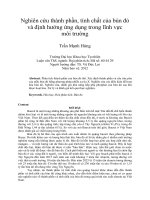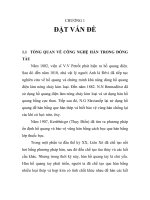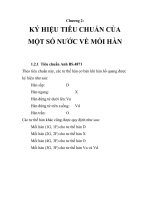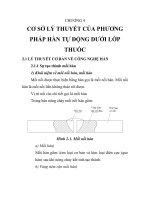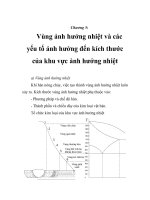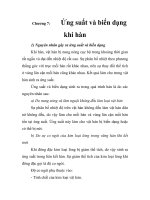Nghiên cứu thiết kế tối ưu mũi dò quét định hướng ứng dụng trong kỹ thuật khắc nano
Bạn đang xem bản rút gọn của tài liệu. Xem và tải ngay bản đầy đủ của tài liệu tại đây (1.84 MB, 67 trang )
MINISTRY OF EDUCATION AND TRAINING
HANOI UNIVERSITY OF TECHNOLOGY AND SCIENCE
INTERNATIONAL TRAINING INSTITUTE FOR MATERIALS SCIENCE
---------------------------------------
LE VAN TAM
STUDY AND OPTIMIZING DESIGN OF
SCANNING PROBES FOR
NANOLITHOGRAPHY
MASTER THESIS OF MATERIALS SCIENCE
Batch ITIMS-2015
SUPERVISOR
Dr. CHU MANH HOANG
Hanoi – 2017
ACKNOWLEDGEMENT
I would like to thank my supervisor, Dr Chu Manh Hoang who has supervised and
encouraged me during my stay at ITIMS.
Acknowledgement would be also sent to all the members of optical micro-nano
systems and sensors technology Laboratory – International Training Institute for
Materials Science (ITIMS).
Finally, thanks should also be given to my family and friends, who always
supported me in my study.
I
LIST OF PUBLICATIONS
1. Le Van Tam, Dang Van Hieu, Vu Ngoc Hung and Chu Manh Hoang, “Design And
Simulation Of Scanning Probe Micro – Cantilever”, National Conference On
Applied And Engineering Physics, pp 285-288, 2015, ISBS 978-604-913-232-2.
2. Le Van Tam, Dang Van Hieu, Vu Ngoc Hung and Chu Manh Hoang, “Electrostatic
Actuator For Improving Scanning Probe Lithography”, 9th Vietnam National
Conference of Solid Physics and Materials Science, pp 393-397, 2015, ISBN 978604-938-722-7.
3. Le Van Tam, Dang Van Hieu, Vu Ngoc Hung and Chu Manh Hoang, “A MicroSuspension Electrostatic Actuator For Improving The Performance Of Scanning
Probe Nanolithography”, 3rd International Conference on Advanced Materials and
Nanotechnology, pp.285-288, 2016, ISBN 978-604-913-232-2.
4. Dang Van Hieu, Le Van Tam, Nguyen Van Cuong and Chu Manh Hoang, “Design
And Simulation Of Serpentine Springs For Scanning Probe”, Workshop on
Advanced Nanomaterials & Nanotechnology, pp.221-224, 2017, ISBN 979-604-950298-9.
5. Le Van Tam, Dang Van Hieu, Nguyen Duy Vy, Vu Ngoc Hung and Chu Manh
Hoang, “Design And Simulation Analysis Of An Electrostatic Actuator For
Improving The Performance Of Scanning Probe Nanolithography”, Vietnam
Journal Of Science And Technology, pp.484-493 55, 4, 2017, DOI: 10.15625/25252518/55/4/8803.
II
STATEMENT OF ORIGINAL AUTHORSHIP
I hereby declare that the results presented in the thesis are performed by the author.
The research contained in this thesis has not been previously submitted to meet
requirements for an award at this or any higher education institution.
Date:
Signature:
III
28/09/2017
TABLE OF CONTENTS
CHAPTER 1 INTRODUCTION ................................................................................. 5
1.1. Scanning probe microscopes (SPMs) ................................................................ 6
1.1.1. Scanning tunneling microscope (STM).................................................... 6
1.1.2. Atomic force microscope (AFM) ............................................................. 7
1.2.
Scanning probe lithography (SPL) .............................................................. 8
1.3.
Mechanical Scratching ................................................................................. 9
1.4. Cantilever actuator .......................................................................................... 14
1.4.1. Thermal bimetallic actuation .................................................................... 14
1.4.2. Piezoelectric actuation .............................................................................. 15
1.4.3. Electrostatic actuation ............................................................................... 16
1.5. Purpose of this thesis ....................................................................................... 17
CHAPTER 2 DESIGN OF SCANNING PROBE ..................................................... 18
2.1 Single degree of freedom mass spring model for electrostatic actuator .......... 19
2.2 Cantilever structure .......................................................................................... 24
2.2.1 Operation frequency and stiffness ............................................................. 24
2.2.2 Cantilever probe actuation and sensing ..................................................... 29
2.3 Clamped-clamped probe .................................................................................. 32
2.3.1 Operation frequency and stiffness ............................................................. 32
2.3.2 Clamped-clamped actuation and sensing ................................................... 35
2.4 Micro-suspension based scanning probe .......................................................... 35
2.4.1 Operation frequency and stiffness ............................................................. 36
IV
2.4.2 Micro-suspension probe sensing and actuation ......................................... 37
2.5 Numerical method ............................................................................................ 39
CHAPTER 3 RESULTS AND DISCUSSION ......................................................... 42
3.1 Natural frequencies and stiffness ..................................................................... 42
3.1.1 Cantilever probe ......................................................................................... 42
3.1.2 Clamped-clamped probe ............................................................................ 44
3.1.3 Micro suspension probe ............................................................................. 45
3.2 Static deflection ................................................................................................ 47
3.3 Dynamic deflection .......................................................................................... 53
CONCLUSIONS ....................................................................................................... 57
FURTURE WORKS .................................................................................................. 58
REFERENCES .......................................................................................................... 59
V
LIST OF FIGURES
Figure 1. 1 The basic configuration of a SPM [2]. ......................................................... 7
Figure 1. 2 The basic configuration of AFM [2]............................................................. 8
Figure 1. 3 Schematic of nanoscale scratching using AFM [17]. ................................. 10
Figure 1. 4 Schematic of top surface imaging concept, the tip scratching on polymer
layer (a); the transfer of the pattern by etching and removing polymer layer (b) [12]. . 10
Figure 1. 5 AFM image of plowed PMMA groove by silicon tip (a). Profile of the
groove (b) [7]. ................................................................................................................ 11
Figure 1. 6 SEM image of diamond-coated tip side view and SEM image of tip top
view [18]. ....................................................................................................................... 12
Figure 1. 7 Main steps of the AFM-based trilayer process (a), AFM image of a furrow
engraved in polyimide (b) [5]. ....................................................................................... 12
Figure 1. 8 The schematic of AFM tip-based dynamic plowing lithography (a). high
scratching velocity (b), medium scratching velocity (c), and low scratching velocity (d)
[9]. .................................................................................................................................. 13
Figure 1. 9 AFM images of an array of pits with a scratching velocity of 400 μm/s [9].
........................................................................................................................................ 14
Figure 1. 10 Probe array using thermal bimetallic actuator [19]. ................................. 15
Figure 1. 11 A schematic of the piezoelectric microcantilever array [10]. .................. 16
Figure 1. 12 A schematic of electrostatic actuation [6]. ............................................... 16
Figure 2. 1 Single degree of freedom mass-spring for electrostatic actuator. ............... 19
Figure 2. 2 Schematic diagram of 2D parallel plate capacitor with fringe field ............ 24
Figure 2. 3 A cantilever probe structure ........................................................................ 24
Figure 2. 4 The first natural frequency of cantilever versus dimensions of cantilever .. 26
Figure 2. 5 The dimensions of probe and forces exert on the tip when probe operating.
........................................................................................................................................ 27
Figure 2. 6 The schematic of unsymmetrical operation mode of the cantilever probe. . 30
1
Figure 2. 7 Parallel capacitance depends on the dimensions of beams and the gap. ..... 30
Figure 2. 8 Schematic of the clamped-clamped probe. .................................................. 32
Figure 2. 9 The first natural frequency of clamped-clamped probe versus dimensions of
clamped-clamped probe. ................................................................................................ 33
Figure 2. 10 The micro-suspension electrostatic actuator. ............................................ 36
Figure 2. 11 Equivalent Lumped-parameter model of the micro-suspension electrostatic
actuator. .......................................................................................................................... 36
Figure 2. 12 The fixed electrode area is equal to the entire back side area of the probe
(a). The fixed electrode area is equal to the backside area of the plate (b). ................... 38
Figure 2. 13 Parallel capacitance depends on the length of the plate and the gap. ........ 38
Figure 2. 14 Schematic time response of an under damped single degree of freedom
system. ............................................................................................................................ 40
Figure 3. 1 The first three mode shapes and natural frequencies of the cantilever probe.
........................................................................................................................................ 42
Figure 3. 2 The first three mode shapes and natural frequencies of the clampedclamped probe. ............................................................................................................... 44
Figure 3. 3 The first three mode shapes and natural frequencies of the micro suspension
probe. .............................................................................................................................. 46
Figure 3. 4 The displacement of tip versus applied voltage. ......................................... 47
Figure 3. 5 The x-displacement versus the z-displacement of tip in the cantilever probe.
........................................................................................................................................ 49
Figure 3. 6 Change in capacitance vs displacement. ..................................................... 50
Figure 3. 7 Tip displacements as a function of applied voltage V0. .............................. 51
Figure 3. 8 Change in capacitance vs displacement ...................................................... 52
Figure 3. 9 Time response of the micro suspension probe with different pressures. ..... 53
Figure 3. 10 Quality factor versus ambient pressure. .................................................... 54
Figure 3. 11 The resonant frequency as a function of applied voltage. ......................... 55
2
Figure 3. 12 Curves of amplitude (a) and phase (b) versus excitation frequency with
Vdc=20V, Vac=2V. .......................................................................................................... 55
3
LIST OF TABLES
Table 1 The properties of air and single crystal silicon. ................................................ 19
Table 2 The values of βnL for first three modes. ........................................................... 25
Table 3 The dimensions of the cantilever probe. ........................................................... 32
Table 4 The values of βnL for first three modes. .......................................................... 33
Table 5 The dimensions of the clamped-clamped probe. .............................................. 35
Table 6 The dimensions of the micro suspension probe. ............................................... 39
Table 7 The natural frequencies of the cantilever probe ................................................ 42
Table 8 The stiffness of the cantilever probe in different vibration directions. ............. 43
Table 9 The natural frequencies of the clamped-clamped probe. .................................. 44
Table 10 The stiffness of the clamped- clamped probe in different vibration directions.
........................................................................................................................................ 45
Table 11 The natural frequencies of the micro suspension probe. ................................ 46
Table 12 The stiffness of the micro suspension probe in different vibration directions.
........................................................................................................................................ 46
Table 13 Pull-in voltage of probe structures. ................................................................. 48
Table 14 Capacitance of scanning probe structures. ...................................................... 49
Table 15 The capacitive sensitivity of the probes .......................................................... 50
Table 16 The capacitance of the micro suspension probe ............................................. 52
4
CHAPTER 1 INTRODUCTION TO SCANNING PROBE NANOLITHOGRAPHY
In the following sections, I will present lithography techniques by scanning probes,
which have been reported in literature. After that the mechanical scratching technique
relating to the content of this thesis is focused on. Advantages and disadvantages are
overviewed. The techniques for actuation and control are presented. Based on the
overview about the lithography technique by scanning probe, we present the purpose
for the thesis.
In 1798, German Alois Senefelder invented a new printing technique of lithography
(from Greek, lithos, “stone”, and graphein, “to write”). After that, Nicéphore Niépce
created the first permanent photographic image by using his process is called
heliography [14]. Based on the Nicéphore Niépce process, photography technique was
invented. Much later, photolithography method was invented with photomasking and
chemical processing. In 1950s, Integrated circuits (ICs) were invented by Jack Kilby
and photolithography method is used mainly in mass production of ICs, because it can
be fabricated very small pattern and has high throughput to reduce production costs.
Since then, semiconductor industry develops continuously photolithography, presently
ICs can be fabricated with 14 nm minimum feature width by photolithography.
However, photolithography has also disadvantages: resolution is limited by diffraction
phenomenon and requires expensive equipment, only suitable for industry. Therefore,
researchers developed a number of methods to substitute photolithography. Particularly
after the invention of first scanning probe microscopy (SPM) in 1981, there are series
of methods use SPM for making sub-100 nm pattern: dip-pen nanolithography,
mechanical scratching… It is generally called scanning probe lithographys (SPLs).
Researchers accidentally discovered the oxidation of sample surface when the rate of
scanning is slow that is called local oxidation method by scanning probe. SPLs are
5
very simple and cheap, we can perform it with only SPL. But SPLs also have a major
downside: low throughput. Currently, researchers are trying to improve and
commercialize them.
1.1. Scanning probe microscopes (SPMs)
Scanning probe microscope (SPM) is a brand of microscope that uses a physical
probe to make an image surface sample with atomic resolution. In this section,
principles of some SPMs will be introduced.
1.1.1. Scanning tunneling microscope (STM)
Scanning tunneling microscope (STM) was invented in 1981 by Binnig and Rohrer
[4]. It uses quantum tunneling effect to make image of sample surface with nano-met
resolution. Figure 1.2 schematically illustrates the basic configuration of the SPM. A
sharp conductive tip is controlled by a piezoelectric transducer, it can move tip threedimensions (xyz) with nano-met precision. The tip is often made of tungsten by
electron-chemical etching. When the tip is brought nearly sample surface (about 1nm)
and applying a bias voltage (mV to a few volt) between the tip and sample, a tunneling
of electrons can appear. Energy of electrons is lower than potential energy of nuclear
but electrons can overcome out of atoms and with bias voltage, an electron current can
be formed between the tip and the sample. The dependence of tunneling current JT on
1/2
distance d and bias voltage VT is JT VT exp( A d ) . Where ϕ is work function and A
is a constant A=1.025eV-1/2/Ao. The tunneling current JT is very sensitivity to change in
distance d, about three orders magnitude for 2-5 angstrom. The tip is scanned on the
sample surface by the piezoelectric transducer, STM can create image of topographical
map of sample surface. There are two operation modes using in STM, constant current
mode and constant distance mode. In constant current mode, the tunneling current is
kept constant by the feedback control loop that changes the distance between the tip
6
and sample. From the change in distance, the topographical image of the sample
surface is created. In constant distance mode, the distance between the tip and sample
is kept constant by the feedback control loop. From the change in tunneling current, the
topographical image of the sample surface is created. Because tunneling current is used
to make image, STM requires a vacuum environment and tip, sample has to be
conductive.
Figure 1. 1 The basic configuration of a SPM [2].
1.1.2. Atomic force microscope (AFM)
After the STM, Atomic force microscope was also invented by Binnig [3]. In an
AFM, the probe has a sharp tip on a flexible cantilever beam. AFM images are created
by measuring forces between the tip and surface, the atomic force deflects the
cantilever, which is detected by an optical system and translated to surface image
(Fig.3). AFM has two modes, contact mode and non-contact mode (tapping mode). In
contact mode, the force or the distance between the tip and surface sample can be kept
constant by a feedback control loop. In tapping mode, the AFM probe is driven to
7
oscillate up and down at high frequency. Unlike the STM, The AFM can be operated in
the air while the STM requires a vacuum environment. Additionally, unlike the STM,
tip and sample of the AFM haven’t to be conductive.
Figure 1. 2 The basic configuration of AFM [2].
1.2.
Scanning probe lithography (SPL)
After the inventing of scanning probe microscopes, a new variety of fabrication
methods based on SPM was discovered that are generally called scanning probe
lithography. Scanning probe lithography is a very simple and cheap setup. Fabricating
patterns at sub-100 nm scale by photons or e-beam requires expensive equipment and
complex processes. In scanning probe lithography, patterns at sub-100 nm can be
easily fabricated with only a SPM.
Unlike photolithography or e-beam lithography only using resist exposure
mechanisms, SPL can be implemented with diverse mechanisms. For example [7]:
• Resist exposure mechanism: Using a conductive substrate is coated an
electron-sensitive polymer layer. The tip is brought close to the surface
substrate. When a bias voltage is strong enough to apply between the tip
8
and a conductive substrate, there is an emission current between the tip
and the surface substrate. Similar to photolithography, the current
changes the chemical properties of polymer layer. Patterns is made by
moving the tip on surface that can be used as a mask for next etching
process.
• Local oxidation lithography: A high electric field can be formed between
tip and sample surface and surface molecules can be ionized. Local
oxidation process of sample surface takes place in air. This mechanism
can directly pattern on silicon, the pattern is used in reactive ion etching
(RIE), or creating dielectric barrier in electronic devices.
• Dip-pen nanolithography: AFM probe is coated a special liquid and the
molecules of the liquid can directly deposit on surface sample.
• Thermomechanical indentation: Sample surface is coated a low-meltingpoint polymer layer. AFM tip was heated and indented on the polymer
layer can be formed by pressing AFM tip into the polymer layer.
• Mechanical scratching: Patterns were simply made by directly scratched
the tip on the sample surface. Mechanical scratching has the highest
resolution in methods was described.
In this report, mechanical scratching method is elaborately introduced, because it is
very simple and cheap method but has the highest resolution.
1.3.
Mechanical Scratching
Mechanical Scratching is a method of creating nanoscale patterns on sample
surfaces. Figure 1.3 schematically illustrates the mechanical scratching using AFM. A
probe is applied a force that makes a contact between tip and sample surface. By
moving sample, the patterns can be formed on sample surface.
9
Figure 1. 3 Schematic of nanoscale scratching using AFM [17].
Figure 1. 4 Schematic of top surface imaging concept, the tip scratching on polymer
layer (a); the transfer of the pattern by etching and removing polymer layer (b) [12].
Because the tip contacts directly with sample surface, the dimensions of pattern
depend mainly on the dimensions of the tip, so the resolution of mechanical scratching
is higher than other SPL methods. The downside of this method is the shallow depth of
pattern, we can improve it by using top surface imaging (TSI) concept, shown in figure
1.4. The sample is coated a thin polymer layer, the tip makes pattern on the polymer
layer and it is transferred into the sample by wet chemical or reactive ion etching.
10
Soft materials are usually used in scratching, such as polymers, biomaterials. In this
case, AFM tip is made of Si or Si3N4 and it slowly wears when scratching on soft
material. Figure 1.5, grooves formed on PMMA resist layer, both sides of grooves are
higher surface sample (two bright line in figure 1.5 (a)) because material is squeezed
from the scratched trench. This issue can be solved by using a strained polymer film,
an internal tensile strain can pull away film from grooves.
Figure 1. 5 AFM image of plowed PMMA groove by silicon tip (a). Profile of the
groove (b) [7].
Scratching hard surface can wear the tip and reduce lifetime of tip. The lifetime of
tip can be improved by coated hard material. The diamond-coated tips can be nearly
unchanged during each scratching (figure 1.6). In figure 1.6, the thickness of the
diamond coating is about 100 nm and the tip radius of curvature is approximately 120
nm. In the top and side views of figure 1.6 the vertex angle of the end triangular
pyramid tip in the last 200 nm is tapered to a half cone angle of 10o at the very end of
the tip.
11
Figure 1. 6 SEM image of diamond-coated tip side view and SEM image of tip top
view [18].
Figure 1. 7 Main steps of the AFM-based trilayer process (a), AFM image of a furrow
engraved in polyimide (b) [5].
During scratching, the AFM tip can operate in both contact mode, tapping mode. In
contact mode, a constant force is applied on the tip controlling the cantilever
deflection. A fabrication process of single-electron transistors based mechanical
scratching with AFM in contact mode is shown in figure 1.7 (a) [5]. In this process, the
AFM probe (L=125µm, k= 5 N/m) scratches nano-line on the polyimide layer and it is
12
transferred into germanium layer by dry etching. Then, the germanium layer is used as
a suspended mask for deposition metal layers.
Figure 1. 8 The schematic of AFM tip-based dynamic plowing lithography (a). high
scratching velocity (b), medium scratching velocity (c), and low scratching velocity (d) [9].
When scratching in contact mode, the probe can be twisted by friction force between
tip and sample surface that can make edge irregularities and tip wear, shown in figure
1.7 (b). To eliminate the phenomenon, scratching sample surface by AFM in tapping
mode is used, it is called dynamic plowing lithography (DPL). In tapping mode, the
cantilever probe vibrates with a constant frequency, near resonant frequency of the
cantilever. The amplitude of the probe is kept constant by feedback loop that changes
the distance between tip and sample surface. In dynamic plowing lithography (DPL),
to overcome the interaction force between tip and sample surface, the amplitude
vibration of probe is about 5-50 times larger than in imaging mode [9] [21] [11]. Figure
1.8 shows schematic of AFM tip-based DPL and pattering with different scratching
velocities. With high scratching, velocity pits can be performed on sample surface.
When decreasing the velocity, pits are overlapped and become grooves. In figure 1.9,
13
AFM image of array pits with high scratching velocity. From the advantages of
dynamic plowing lithography, in this thesis, scanning probes are designed for dynamic
plowing lithography.
Figure 1. 9 AFM images of an array of pits with a scratching velocity of 400 μm/s [9].
1.4. Cantilever actuator
A common issue for all SPL is low throughput. This would not be a serious problem
for laboratory where the cost of production is not attentional. But in industrial
production, the throughput issue has to be resolved. A solution is to pattern in parallel
fashion with multiple probes. There are two types of probe arrays: active probe arrays
and passive probe arrays. In the passive probe arrays, probes cannot individually
control. Active probe arrays are more advanced, probes can individually control by a
sensor and actuator that is integrated into each probe, it can be made different patterns
by each probe. In a probe array, the cantilever probe is commonly used. To control
each cantilever in the array, there are three actuation methods: thermal bimetallic,
piezoelectric, and electrostatic actuation.
1.4.1. Thermal bimetallic actuation
Like a bimetallic strip, two materials layers are used to make cantilevers such as
gold and silicon or silicon nitride. In this method, a cantilever is coated a thin film
metal layer onto the top the probe. The metal film is similar to an ohmic heater. The
14
probe is curled away from the substrate when heated and return to the surface when
cooled (Figure 1.10) [19]. The thermal bimetallic actuation can provide large
displacement and linearly proportional between displacement and power. However, it
requires high power and has low bandwidth.
A problem with thermal bimetallic actuation is heat transfer between probes,
because of conduction through the air, substrate and radiation between probes. This
phenomenon can entrain to erroneously control probes. In addition, when used dip-pen
nanolithography, the high temperature of the probe can affect temperature-sensitive
chemicals.
Figure 1. 10 Probe array using thermal bimetallic actuator [19].
1.4.2. Piezoelectric actuation
In this method, the probe is controlled by using the inverse piezoelectric effect. The
probe is coated a piezoelectric material, shown in figure 1.11 [10]. When a bias voltage
is applied to a piezoelectric crystal, the dimension of crystal is changed to reduce probe
curl. The piezoelectric actuation has large bandwidth, low voltage applied. However, it
proves small displacement and to deposits piezoelectrical materials, it requires
complex fabrication process.
15
Figure 1. 11 A schematic of the piezoelectric microcantilever array [10].
1.4.3. Electrostatic actuation
Figure 1. 12 A schematic of electrostatic actuation [6].
The concept is to use electrostatic force to deflect cantilever, shown in figure 1.12
[6]. The surface holder and the back of the probe are coated a thin film metal layer to
form electrodes. When a bias voltage is applied between two electrodes, the probe can
be deflected by electrostatic force. The electrostatic actuation operates with low power
and no heat. So, it can eliminate the heat transfer between probes, suitable for sensitive
chemicals without damage. To measure the displacement of the tip, we can use
capacitive sensor. The deflection of probe causes a change in capacitance between two
16
electrodes. For small deflection, the displacement of tip is linear with change in
capacitance. The capacitive sensor is simple and easy integration compared to optical
detection systems. In addition, it is suitable for scanning probe array and operating in
vacuum. Therefore, in this thesis, electrostatic actuation method and capacitive sensor
are used for controlling scanning probe.
1.5. Purpose of this thesis
Scanning probe nanolithography is a low-cost nanoscale patterning technology that
can be replaced for expensive photo nanolithography. In recent years, nanofabrication
by scanning probe is being developed and commercialized. Current studies have
focused on increasing the throughput and reliability of SPL. One of the solutions to
increase the throughput is using SPL array. This thesis presents the design and
simulation of scanning probes using for SPL array. The designs of the scanning probes
are suitable for fabrication by MEMS and aim at improving the accuracy and
increasing the throughput. To control each probe in the array, the electrostatic actuation
and capacitive sensing methods are used. The operation characteristics of the scanning
probes are also simulated by finite element method.
17
CHAPTER 2 DESIGN OF SCANNING PROBE
In this chapter, the design of scanning probes for nanolithography will be presented.
The downside of the common cantilever probe is indicated. So, two novel scanning
probe structures are proposed, these structures not only overcome the downside of the
cantilever structure, but also increase the throughput of SPL. Theoretical expressions
and numerical method for analyzing operational characteristics of the electrostatic
actuator is presented. From that, a design guideline of the electrostatically actuated
scanning probe is suggested.
Before presenting the designs of the scanning probe, several design requirements
based on technology conditions and published researches are proposed:
• The structure of scanning probe is suitable for fabrication by MEMS.
• To integrate with a controllable electronic circuit, the capacitance should be
larger than 100fF.
• The voltage applied is small enough to prevent the cross talk between scanning
probes in array [6].
• Because of operating in resonance mode, the distance between nature
frequencies of scanning probe should be large enough to suppress the cross-talk
causing by mechanical coupling phenomena. To achieve high machining speed,
the operating frequency should be larger than 100kHz [11] [12] [21].
• The area effective of structure has to be optimized to increase density of array
• When probes operate in tapping mode, the quality factor of structure should be
larger than 100 [22].
In order to investigate the scanning probe, theoretical analysis and numerical
method are used and several assumptions for simplifying calculations are given:
• The probe is made of single crystal silicon, the characteristics of the mass and
hardness are constants which are not dependent on time and frequency.
18
• The assumptions of the kinematic theory conform to Bernoulli-Euler beam
theory.
For calculating the operating characteristics of the probes, the properties of air and
single crystal silicon are shown in table 1.
Table 1 The properties of air and single crystal silicon.
Properties
Air
Silicon
Density (Kg/m3)
1.2
2329
Elastic modulus (N/m2)
170x109
Poisson ratio
0.26
Dielectric Constant
1
Viscous (Ns/m2)
1.8x10-5
11.68
2.1 Single degree of freedom mass spring model for electrostatic actuator
Figure 2. 1 Single degree of freedom mass-spring for electrostatic actuator.
Before studying specific probe structures, the operating characteristics of
electrostatic actuator will be presented. In order to simplify the structure of
electrostatic actuator, we consider a single degree of freedom mass-spring system
model for electrostatic actuator, as shown in figure 2.1. The system consists of a
parallel capacitor with a movable electrode that has effective mass meff and connected
19

